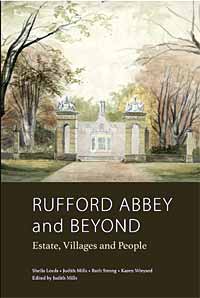Book launches and reviews, Winter 2023
Rufford Abbey and Beyond : Estate, Villages and People
Authors: Sheila Leeds, Judith Mills (editor), Ruth Strong & Karen Winyard. ISBN: 978-1739391409
Publisher: Friends of Nottinghamshire Archives (2023)

This is the third book to be published by the Friends of Nottinghamshire Archives since 2019 and undoubtedly its most ambitious publication to date. It is based on a research project initiated between Inspire (which runs the Nottinghamshire Archives) and FONA, which exists to support and promote the archives and its collections. The Savile collection is one of the largest and most under-utilised of the Archives’ historic collections of estate papers, so it is entirely fitting that FONA participated in a project to list, itemise and contextualise a small but revealing selection from this vast and enthralling collection. The results of the project are written up and presented in this book, which benefits greatly from the outstanding graphic design skills of Bob Stokes. The result is an attractive, engaging and affordable insight into one of the great, though under-appreciated, Nottinghamshire estates. Historians well used to looking further north into the Dukeries will be reminded that the Saviles of Rufford, whilst lacking ducal status, enjoyed possession of one of the finest ( and today one of the most accessible) landscapes in the county. Its family contained the usual range of colourful and eccentric characters, whilst the descent of the title was complex and occasionally litigious. The authors, who will be familiar to members of the Thoroton Society as skilled and committed researchers in their own right, have combined together to produce chapters relating to the areas of research in which they specialised during the project. Multiple chapters cover the estate (both owners and workers), the county pursuits of hunting, shooting and horse racing and the family’s overseas diversions. The research is presented in crisply-written and fully referenced chapters. Even more usefully, the contributors set out a potential series of follow-on projects, which those inspired by the group’s work can follow up for themselves. The book offers an excellent example of what a small team of dedicated researchers can achieve in co-operation with an archives section, given a shared sense of purpose. Whether FONA exists to do more than write up the results of its own research is a question which might usefully be asked, but it takes nothing away from the publication of this timely and well conceived collection of essays.
Richard Gaunt